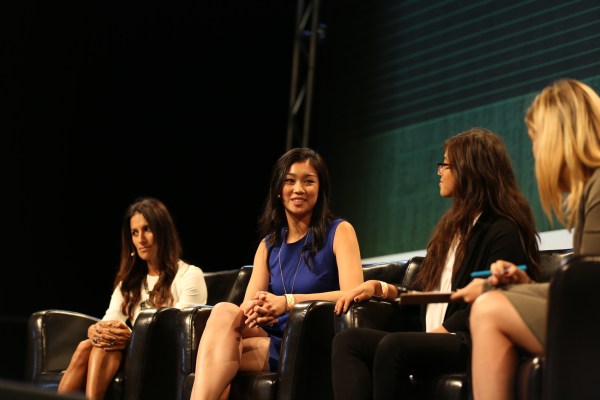Diversity is the hot topic in Silicon Valley and the tech industry at large these days. Today at Disrupt SF 2015, TechCrunch former Co-Editor Alexia Tsotsis took the stage to lead a discussion on diversity with Pinterest Engineer Tracy Chou (who got tech companies to release their diversity data), OneLogin engineer Isis Anchalee (who started the #ILookLikeAnEngineer hashtag), and Joyus Founder and CEO Sukhinder Singh Cassidy.
But do we really need diversity in tech panels? Last week at Dreamforce, Re/Code’s Kara Swisher said that we need to get to a point where diversity panels are no longer necessary. Swisher said that in response to Salesforce CEO Marc Benioff’s comment about the importance and value of panels for women. In a perfectly diverse world, we wouldn’t need all-women panels, or panels that focus on diversity. But we’re just not there yet.
“I think we need to keep talking about this until senior leadership, demographics, VC firms and the industry actually represents the greater population it’s drawing from,” said Chou.
By the look of the state of the diversity at tech giants like Apple, Google and the like, it’s going to be a while until we can stop talking about diversity.
In August, Apple released a new diversity report, showing just slight progress in hiring people who are more diverse than white men. In the last year, 11 percent of Apple’s hires in the U.S. have been black, 13 percent have been Hispanic and 19 percent have been Asian. Worldwide, Apple hired 65 percent more women than it did in the previous year.
As you’ve probably noticed, when tech companies talk about diversity, it often starts with the lack of women in tech, and then the lack of people of color in tech. What’s problematic is that the conversation around diversity ends up not being inclusive.
[gallery ids="1214824,1214822,1214821,1214816,1214817,1214818,1214815,1214820"]
“I think it’s easiest to start with women because women are 50% of the population so it’s very obvious when we’re not at 50/50 that there’s an imbalance,” Chou said. “It’s harder to see that for other forms of diversity. Race is the other visible diversity stat that we’re looking at but even then it’s hard to know if we’re representing the overall population demographics.”
The other thing that makes it easier to tackle gender first is that every man has a mother, Chou said. They also sometimes have wives, sisters or daughters. What puts racial diversity on the back-burner to gender diversity, Chou said, are questions of socioeconomic class. Another thing, Chou said, is that peoples’ social networks tend to be very racially homogenous.
“So it’s easiest to start with gender and then race is the next one because these are the two visible markers,” Chou said. “Other forms of diversity are important and I think it’s critical that we don’t just define diversity as gender diversity or racial diversity, but those are the things that we should start with. They’re the most obvious problems we have and they’re also the easiest ones for companies to set targets around.”
Pinterest is doing just that — putting concrete goals in place to improve diversity. Chou pointed to how Pinterest has been working with consulting startup Paradigm to better understand what problems the company has and how those problems — from sourcing potential candidates to hiring to employee evaluations — can best be addressed.
“Every company will have its own biases so I think it’s important for each company to look at its own problems and where the highest leverage points are for them, instead of saying that every company needs to do the same things to fix their problems,” Chou said.
Outside of tech companies, there are obviously problems in the venture capital world. Earlier this month, former Kleiner Perkins Caufield & Byers partner Ellen Pao said she would not appeal the gender discrimination lawsuit she filed against the firm three years ago. But this case has surely impacted and propelled the conversation around diversity in tech.
“I think it was an inflection point for sure,” Cassidy said. “I think regardless of what you think about the case, there’s no doubt. I’ve heard the phrase unconscious bias more in the last six months than I have in the last 20 years.”
Although the case didn’t turn out the way some had hoped, it’s definitely been a conversation starter around diversity and inclusion in the tech industry.
“Once we had the data out there and people recognized that there was a problem that was quantifiable, Eileen gave a story that was there and people relate much more to stories than they do to statistics,” Chou said. “I think just laying it out all there and making it a conversation piece was really important for the industry.”
